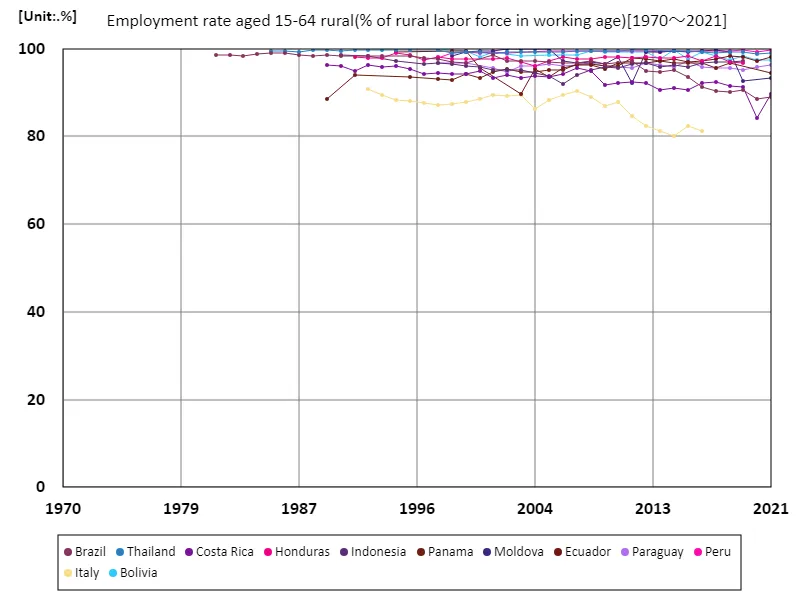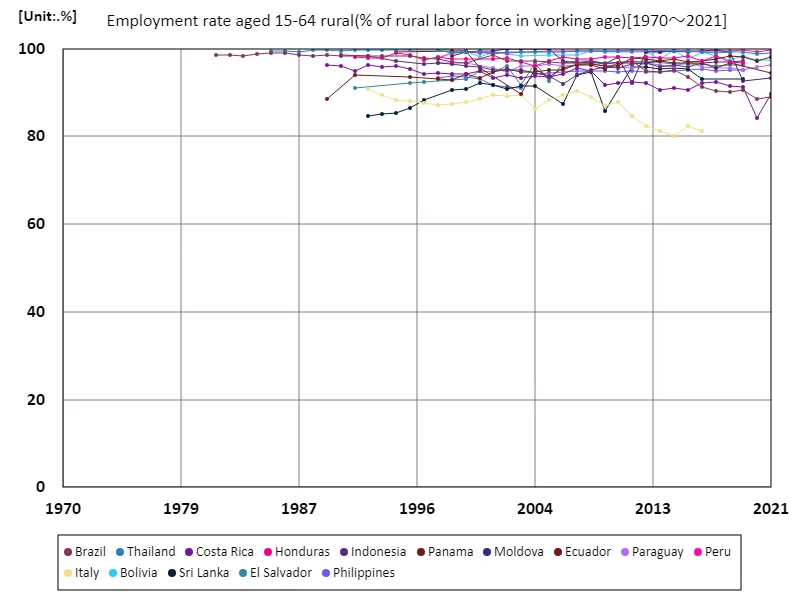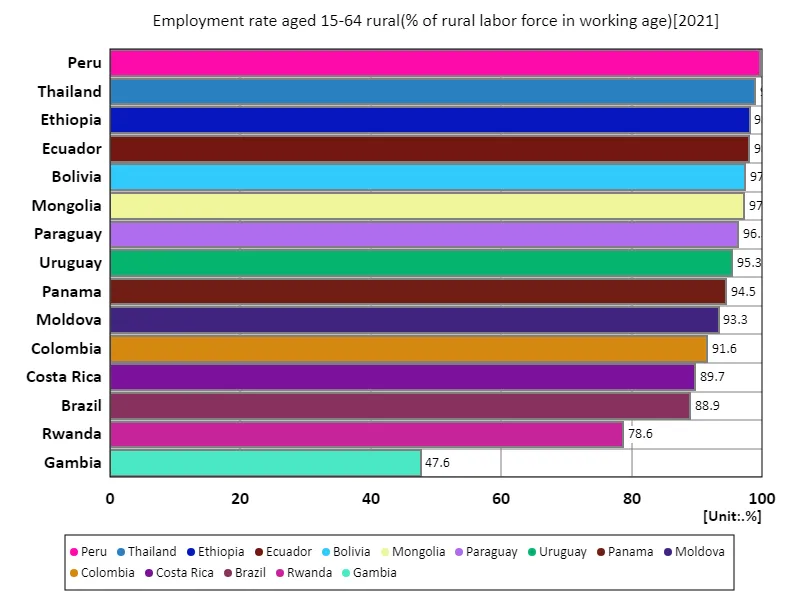- Abstract
- Employment rate for people aged 15-64 in rural areas (as a percentage of the total rural labor force)
- Employment rate in rural areas (percentage of total rural labor force) for ages 15-64 (worldwide)
- Employment rate in rural areas (as a percentage of total rural labour force) for ages 15-64 (world, latest year)
- Employment rate for people aged 15-64 years, rural (% of total rural labour force) (region, latest year)
- Reference
Abstract
Employment rate data shows the proportion of employed people in relation to the working-age population and can help gauge the health of the economy and the state of the labour market. In 2021 data, Peru recorded the highest employment rate at 74.7%. This could signal success in Peru’s economic growth and job creation. Over the past few decades, employment rates have varied widely across countries, but some countries have maintained high employment rates due to economic growth and policies. On the other hand, employment rates can be low in countries with economic recession or structural problems. A country with high employment rates, such as Peru, reflects efficient labor markets and strong economic activity, and sustainable growth strategies and labor market reforms are important to maintain this.
Employment rate for people aged 15-64 in rural areas (as a percentage of the total rural labor force)
Looking at data from 1974 to 2021, Thailand’s employment rate peaked at 84.3% in 1989, and although it declined temporarily thereafter, it has now returned to a high level of 86.9%. The fluctuations reflect changes in Thailand’s economic growth and labor market. In the late 1980s and early 1990s, Thailand experienced rapid industrialization and economic development, resulting in a peak in employment rates. However, there was a temporary decline after that due to the Asian currency crisis, economic maturity, structural reforms, and other factors. Nevertheless, the recent recovery is evidence of Thailand’s economic stability and growth, and is likely a result of the government’s labour market policies and economic strategies. In particular, industrial diversification, improved educational standards, and increased employment opportunities have contributed to this, and efforts toward sustainable job creation are important.


The maximum is 100%[2005] of Moldova, and the current value is about 93.3%
Employment rate in rural areas (percentage of total rural labor force) for ages 15-64 (worldwide)
Based on data spanning 1974 to 2021, Thailand’s employment rate peaked at 84.3% in 1989. The high employment rate during this period is due to Thailand’s rapid economic growth and industrialization. The employment rate subsequently declined temporarily due to events such as the Asian financial crisis (1997), but Thailand has since recovered through economic diversification and policy reforms. The current employment rate of 86.9% is above its peak, indicating labor market stability and economic health. This is believed to be due to the Thai government’s labor market policies, investment in education, and industrial sophistication. To maintain high employment rates, sustainable growth strategies and labour market reforms are needed going forward.


The maximum is 100%[2005] of Moldova, and the current value is about 93.3%
Employment rate in rural areas (as a percentage of total rural labour force) for ages 15-64 (world, latest year)
According to 2021 data, Peru recorded the highest employment rate for the working-age population aged 15-64 at 74.7%, while the overall average was 61.3%. Peru’s high employment rate is a result of its growing economy and expanding labor market, particularly as it develops as an emerging market. The average of 61.3% reflects the difference between developed and developing countries, where different economic conditions and policies affect employment rates. In addition, the total figure of 981% is a combination of data from each country, and can be used as a reference when looking at the economic situations of different countries. Historically, employment rates have risen in some countries as a result of economic growth and policies, while in other countries they have stagnated due to economic problems or structural challenges in the labor market. Sustained growth strategies and policy flexibility are key to improving the labor market.


The maximum is 99.6% of Peru, the average is 91%, and the total is 1.36k%
Employment rate for people aged 15-64 years, rural (% of total rural labour force) (region, latest year)
The rural employment rate of 73.4 percent, based on 2008 data, reflects the situation in the Central African Republic in particular. This employment rate indicates that the labour force in rural areas is highly dependent on agriculture. While a high employment rate may seem like a good thing at first glance, in reality many workers are likely to be in non-regular employment or working under unstable conditions, and the challenge is that it has not led to an improvement in living standards. Additionally, educational opportunities and vocational training are limited in rural areas, making it difficult for workers to improve their skills, which tends to reduce competitiveness. Furthermore, as urbanization progresses, there are concerns that young people will migrate to urban areas, resulting in a decline in the rural labor force. Against this background, there is a demand for sustainable agriculture and diversification of local economies, and strategies to improve the employment environment in rural areas are needed. Although the employment rate in rural areas is high, improving the quality of that employment will be an important challenge for the future.


The maximum is 73.4% of Central African Republic, the average is 73.4%, and the total is 73.4%



Comments